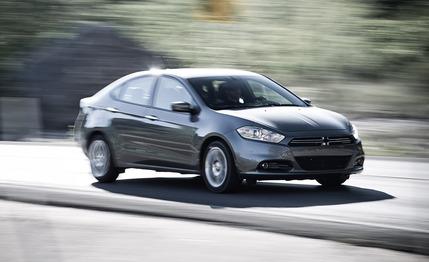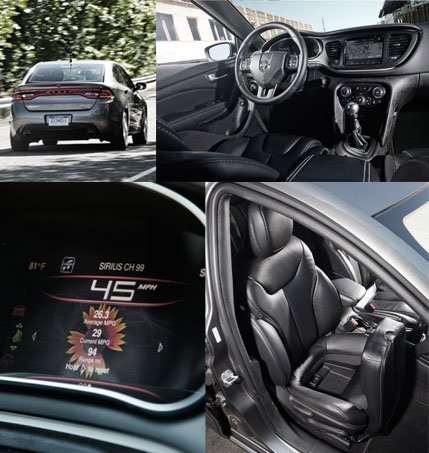 Instrumented Test
Instrumented Test

To be honest, the Dodge Dart in this road test is only a 39-mpg vehicle. As with most other frugal small cars, the Dart’s inclusion in the 40-mpg club is based on a single model, the Aero, available this fall and promising “at least” 41 mpg on the EPA highway cycle. The window-sticker numbers exist on the borderland of make-believe, much like the concept of limited government. That is to say, you probably won’t see much real-world difference between a standard 39-mpg Dart and a Dart Aero.
It’s not so much about to which side of the magic four-oh line the entry-level Dodge falls but that it sits there with previously unseen levels of creature comforts in an economy car. This is the anti-penalty box.
The dated chunkiness of the departed Caliber is replaced by smooth lines and a forward-canted nose that shows off the latest interpretation of the Dodge crosshair grille. Twelve exterior paint shades come at no extra cost, and 14 interior-color combinations span the five trim levels. Hard plastic, the defining feature of Caliber interiors, is all but gone in the Dart. Even on the base rental-class $16,790 SE model, soft padding greets your fingers and elbows on the dashtop, on the door armrests, and on the sliding center console. Outside, a laser-brazed roof leaves no visible seams. Both the trunk and the clamshell hood are gasket-sealed, and the underbody is almost fully clad in smooth plastic panels. These aero improvements yield higher fuel economy (as do the active radiator shutters standard on upper trim levels; they’re part of an equipment package on lower models), but they also make the Dart look and feel more substantial than the stereotypical econobox.

One step up is the $18,790 SXT, which offers a long list of options in modern prepackaged or old-school á la carte form. Don’t like what the dealer has on the lot? Dodge promises to spec it your way and deliver from the Belvidere, Illinois, assembly line in 30 to 60 days.
Our Limited test car, starting at $20,790, comes with a seven-inch reconfigurable instrument cluster that serves as the speedometer (digital or analog-style) and the trip-computer display. The crisp TFT (thin-film transistor) graphics help to elevate the Dart above its everyman pricing. The centered 8.4-inch infotainment touch screen is standard at this level, as are headlamps with an automatic setting, a storage bin under the front passenger’s seat, and a backup camera. Add navigation, leather heated seats and steering wheel, automatic climate control, and the turbocharged 1.4-liter MultiAir engine, and you get $24,070 as tested. Should you want to push the window sticker deeper into the land of mid-level Honda Accords and Volkswagen Passats, you can get blind-spot and cross-path monitoring, keyless ignition, and active headlights for $995.
A big chunk of the as-tested price arises from the engine’s $1300 premium. It has the same 160 horsepower as the base 2.0-liter but peaks 900 rpm earlier, with a 36-pound-foot increase in torque, to 184. It’s similar to the engine in the Fiat 500 Abarth, where it has to move only 2545 pounds. The Dart weighs 3266 pounds—porky relative to the 515-pound-lighter Honda Civic. The Dart outweighs the Chevy Cruze, the heaviest car in our May 2011 “Startup Sedans” comparo, by 86 pounds.